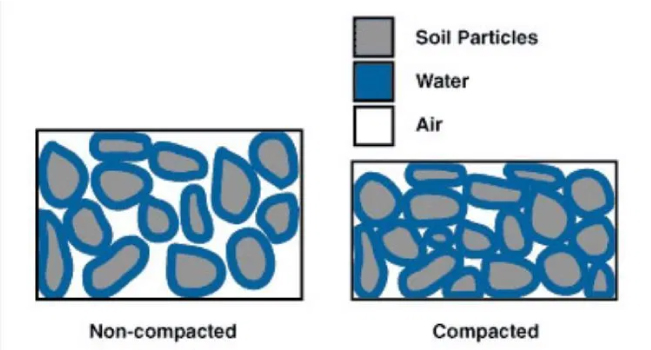What is the Air Spade?
A new essential tool in tree care is a pneumatic device called the Air Spade that utilizes compressed air to safely and efficiently break up difficult/compacted soil… Accessing root systems with an Air Spade is done for a number of reasons and benefits.
An arborist may want to check for root rot beneath the surface, break up compacted soil that has been preventing nutrient and water flow to the roots, assess and correct girdling (circling) roots.

Compacted Soil – Soil compaction occurs when soil particles are pressed together, reducing pore space between them. Heavily compacted soils contain few large pores, less total pore volume and, consequently, a greater density. A compacted soil has a reduced rate of both water infiltration and drainage.
Soil compaction concerns have been growing in the Midwest as both annual precipitation and farm equipment size have dramatically increased.
Wet soils are particularly susceptible to compaction. Heavy equipment and tillage implements amplify damage to the soil’s structure, decreasing pore space and limiting soil and water volume even further.
Improving soil structure is the best defense against soil compaction. A well-structured soil holds and conducts the water, nutrients and air necessary for healthy tree root activity.

Stem Girdling Roots – Imagine wearing a belt around your waist that is being squeezed tighter and tighter, and you’ll get an idea of what girdling roots do to a tree. Girdling roots are more common than many people realize, yet they can be deadly and unknown to most home owners. When lateral roots at (or sometimes, just below) the surface of the soil encircle or cut into the main trunk of a tree, the flow of water and nutrients becomes restricted. The longer a tree has to deal with girdling roots, the weaker and more unstable it becomes.
Typically, girdling roots don’t just “happen.” Trees in urban environments are exposed to certain factors trees in nature don’t have to contend with, which can cause numerous issues, including girdling roots. The most common cause is improper planting/transplanting. When trees remain in their nursery containers for too long, the roots can circle the bottom of the pot, having nowhere else to go. When these roots are not loosened during the planting process, they can become girdling roots.
Similarly, when a tree is planted in a hole that is too small, the same process occurs: the tree’s roots begin circling one another and in time develop into girdling roots. Leaving pieces of the planting container or other debris in the planting hole can also lead to girdling roots down the road. Other causes include heavily compacted soil and close proximity to foundations, curbs and other obstructions, all of which can hinder normal root growth.










